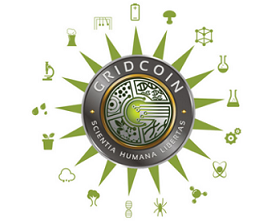
Gridcoin - scientific benefit through mining
Winter is coming to Northern Hemisphere and, soon enough, all sorts of heaters will start consuming a lot of electric energy. But what if you could get paid for electric energy you spend on producing heat? And even more important, why use all that electric energy just to turn some metal red-hot? What if it could be also used for some useful scientific computations and advancing biomedicine, mathematics and technology in turn? Sounds like science-fiction? It's possible today with Gridcoin - a digital currency which is securely rewarding BOINC computations on top of Proof-of-Stake.
GPU mining and the power/heat issues
BOINC is an open-source software platform for computing using volunteered resources. There are many different BOINC projects, covering all fields of science. Many popular BOINC projects have both CPU and GPU applications, enabling you to contribute some serious computing power to the scientific projects of your choosing. However, that computing power comes at a price - modern graphic cards consume a lot of electric power, up to 300 watts when overclocked and running BOINC GPU applications (which are usually very demanding and thus power hungry). If you have four such graphic cards in your PC, that's 1200 watts just for your GPUs and all that power gets converted to heat eventually. It's impossible to dissipate so much heat just with air-cooling, but it's certainly possible with water.
Watercooling your BOINC/Gridcoin machine
Watercooling enables you to build an extremely powerful PC, at acceptable noise-levels and aesthetically unobtrusive. Such machine can then be placed in your living-room, without making it look like a workshop.
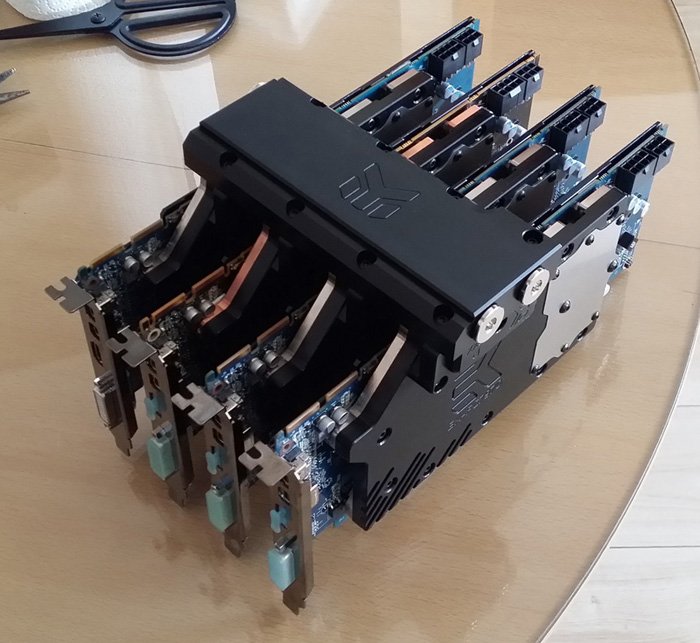
Four graphic cards (AMD Radeon HD7970) with waterblocks and a bridge, ready for installation in PC case
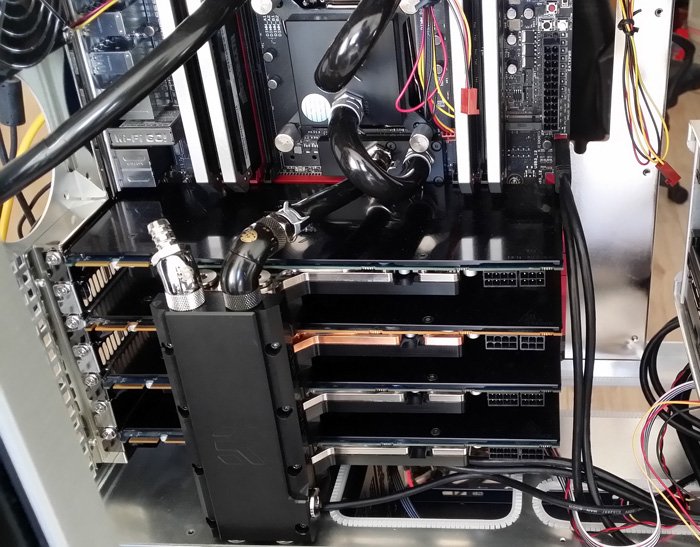
Four graphic cards, installed in PC case, with some tubing already connected
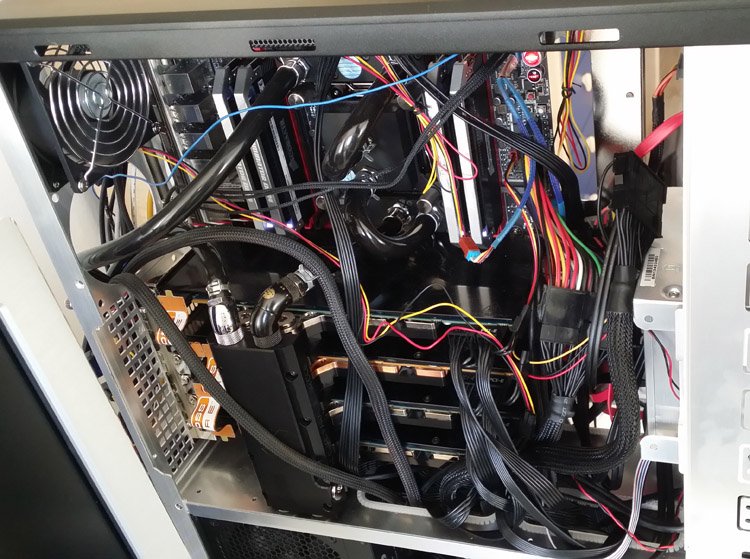
Everything is fully connected here. Only the biggest cases will have enough room to comfortably fit so many components. This is Silverstone TJ07 which is medium-sized, so it's messy with so much stuff inside. However, with watercooling, airflow inside the case is of little importance - heat is carried away by water, flowing through the tubes and waterblocks. So you can just close the case and forget about cable-management :)
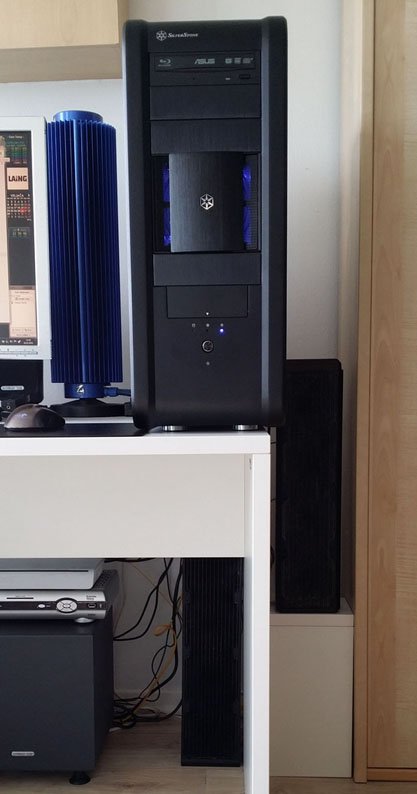
Fully assembled watercooled PC, with two 480mm radiators and a reservoir (blue cylinder) outside the case
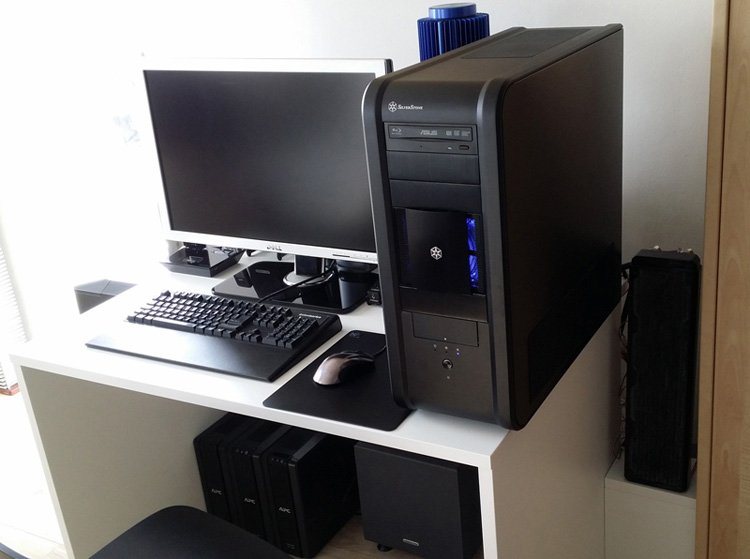
Another view of the whole desktop, placed inside the living room. Looks normal enough :)
Full specs of this machine:
- CPU Intel Core i7-5930K Haswell-E
- ASUS Rampage V Extreme X99
- Corsair Dominator Platinum 16GB DDR4 3000MHz 4x4GB Kit
- 4 x AMD Radeon HD7970
Power consumption is at 1150 watts altogether, even when GPUs aren't overclocked. I measure the power consumption through two APC UPS, which provide backup power for my desktop PC:
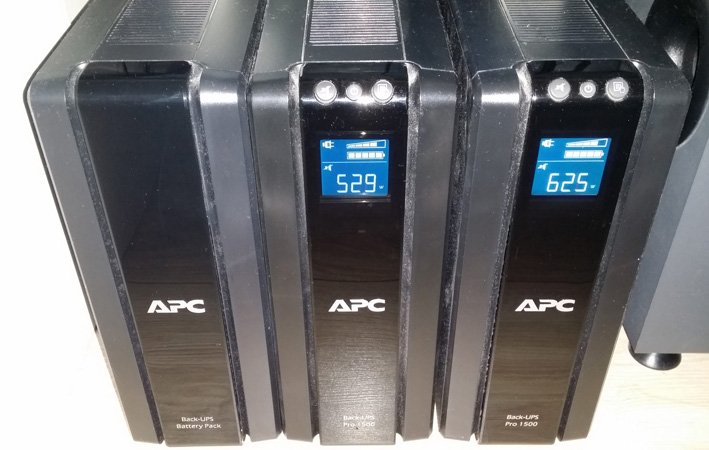
Pulling 1154 watts from the wall, under moderate BOINC load
With water, it's possible to cool any PC you can possibly build with today's technology. Here is a short Youtube video of four HD7990 graphic cards, cooled by nine 360mm radiators (not mine unfortunately):
Gridcoin mining and earnings
I am currently running Milkyway@home BOINC project on my desktop. Milkway@home is creating a highly accurate three-dimensional model of the Milky Way galaxy and is particularly well-suited for HD7970 GPUs, which have very high FP64 (double-precision) performance, which is in turn required for computations performed by Milkway@home. With such a setup, it's possible to earn about 250 Gridcoins (GRC) per day. At present prices, that's worth about 2 USD. Unless you have some really cheap electric energy in your area, that's not nearly enough to cover your electric bill. But, with 1200 watts of heat getting dumped in your living room all the time, there is very little need for any extra-heating during the winter (I live in Mediterranean Europe, so winters are generally mild here). Of course, there are many crypto-coins out there which use Proof-of-Work and which can also use your GPUs for mining. But only Gridcoin can reward actually widely useful scientific computations performed by BOINC. So, in fact, I am using computational science to heat up my living room, and if you ask me, that's way more cutting edge than running repetitive Proof-of-Work hashes.
Recognition for your contribution to science
Some other BOINC projects, like Einstein@home, go far further in recognizing your contribution to science. If you happen to discover a new binary radio pulsar, new gamma-pulsar or a new source of gravitational waves (Einstein@home is looking for such things), your name will be published in The Astrophysical Journal (a very prestigious scientific publication), as a co-discoverer. You will also receive a discovery certificate from the project scientists.
More interested in mathematics? If you happen to find a new large prime-number (through PrimeGrid BOINC project), your name will be published in Chris Caldwell's The Largest Known Primes Database. Both Einstein@home and PrimeGrid (and 28 other scientific projects) are whitelisted by Gridcoin, meaning that if you are running either (or both) of them on your PC, you will also receive Gridcoins as a reward for your computing efforts.


